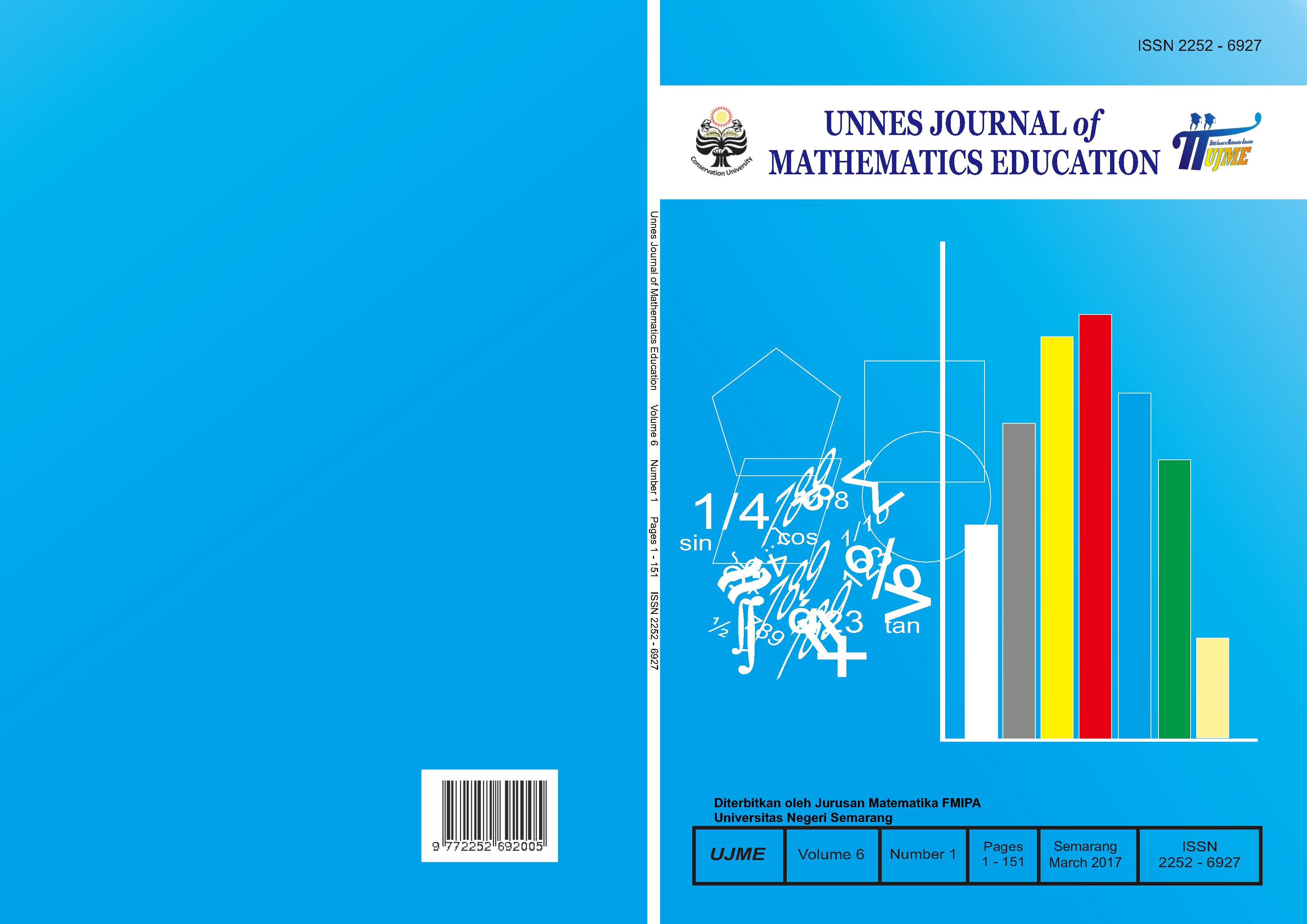Creative Problem Solving Learning to Fix Errors Eighth Grader In Problem Solving Matter Pembelajaran Creative Problem Solving untuk Mengatasi Kesalahan Siswa Kelas VIII Pada Soal Pemecahan Masalah Section Articles
##plugins.themes.academic_pro.article.main##
Abstract
Penelitian ini dilatarbelakangi oleh temuan kesalahan siswa dalam menyelesaikan soal pemecahan masalah. Tujuan penelitian ini adalah mendiagnosis tipe kesalahan siswa berdasarkan prosedur Newman, kesulitan belajar siswa, dan mengetahui keefektifan pembelajaran Creative Problem Solving untuk mengatasi kesalahan siswa. Subjek penelitian adalah 9 siswa kelas VIII D di SMP Negeri 18 Semarang, yaitu masing-masing 3 siswa dari kelompok atas, kelompok tengah, dan kelompok bawah. Pembelajaran dengan metode pemecahan masalah diajarkan kepada siswa untuk mengajarkan kemampuan pemecahan masalah. Hasil penelitian ini yaitu (1) tipe kesalahan yang dilakukan siswa kelas VIII D adalah comprehension errors (tipe C), transformation errors (tipe T), process skills errors (tipe P), dan encoding errors (tipe E); (2) letak kesulitan belajar paling banyak adalah menentukan nilai panjang, lebar, atau tinggi yang sesungguhnya dan sifat kesulitan belajar paling banyak adalah psikologis; dan (3) pembelajaran Creative Problem Solving efektif untuk mengatasi kesalahan siswa sebagai subjek penelitian berdasarkan prosedur Newman dalam menyelesaikan soal pemecahan masalah.
This research was motivated by findings students’ mistakes in solving the problem-solving exercises. The purpose of this research is to diagnose students’ error type based on Newman’s procedure, students’ learning difficulties, and to know the effectiveness of Creative Problem Solving learning in solving students’ mistakes. The subjects of the research are taken from the 9 students of grade VIII D SMP Negeri 18 Semarang, respectively 3 students from the top group, middle group, and lower group. Learning process using problem-solving methods taught the students about the problem-solving skills. The results of this research are (1) the type of errors made by students in grade VIII D are comprehension errors (type C), transformation errors (type T), process skills errors (type P), dan encoding errors (type E); (2) the learning difficulties are mostly in determining the value of the length, width, or height of the real and the characteristics of learning difficulties are mostly in psychological; and (3) Creative Problem Solving learning effectively overcome the mistakes of research subjects based on Newman’s Procedure in solving the problem-solving exercises.
##plugins.themes.academic_pro.article.details##
References
Jha, S.K. (2012). Mathematics performance of primary school students in Assam (India): an analysis using Newman procedure. International Journal of Computer Applications in Engineering Sciences, 2(1): 17-21.
Junaedi, I. (2012). Tipe kesalahan mahasiswa dalam menyelesaikan soal-soal geometri analitik berdasar Newman’s Error Analysis (NEA). Kreano, 3(2): 125-133.
Kartono. (2010). Hands on activity pada pembelajaran geometri sekolah sebagai asesmen kinerja siswa. Kreano, 1(1): 2132.
Makmun, A.S. (2004). Psikologi pendidikan. Bandung: Remaja Rosdakarya.
Moleong, L.J. (2007). Metodologi penelitian kualitatif (edisi revisi). Bandung: Remaja Rosdakarya.
Mulyadi. (2010). Diagnosis kesulitan belajar dan bimbingan terhadap kesulitan belajar khusus. Yogyakarta: Nuha Litera.
NCTM. (2000). Principles and standards for school mathematics. USA: NCTM.
Pujiadi, Kartono, & Asikin, M. (2015). Influence of Creative Problem Solving aided with interactive compact disk towards mathematics learning achievement of grade X students. International Journal of Education and Research, 3(3): 611-618.
Ruseffendi, E.T. (1991). Penilaian pendidikan dan hasil belajar siswa khususnya dalam pengajaran matematika untuk guru dan calon guru. Bandung: FMIPA IKIP Bandung.
Sugiyono. (2010). Metode penelitian pendidikan pendekatan kuantitatif, kualitatif, dan R&D. Bandung: Alfabeta.
Treffinger, D.J., Isaksen, S.G., & Stead-Dorval, K.B. (2006). Creative Problem Solving: an introduction (4th ed.). Texas: Prufrock Press Inc.
Utami, R., Kartono, & Waluya, S.B. (2015). Pencapaian kemampuan dan keterampilan pemecahan masalah matematika siswa kelas VIII pada pembelajaran model CPS dan TAPPS. Unnes Journal of Mathematics Education, 4(3): 239-247.
White, A.L. (2010). Numeracy, literacy and Newman’s Error Analysis. Journal of Science and Mathematics Education in Southeast Asia, 33(2): 129-148.
